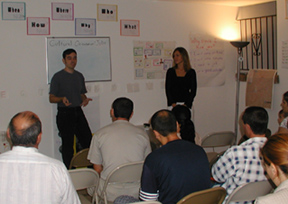|
Living life in a new country successfully is not an immediately evident proposition. People need guidance as to the expectations and customs of their new homeland as well as knowledge of what elements of their own culture may complement or conflict with their new surroundings. Refugees must learn and adapt especially quickly since they have very little network and yet must begin making their own way financially very soon after arrival. Case managers must present culturally-appropriate and useful information as we first meet with new refugees to prepare them for their new life. It is thus critical to focus on the most immediate problems for orientation and find ways to help people understand the basic necessities despite the overwhelming transition they are facing.
For the past few years, the arrival of large numbers of refugees from specific ethnic groups within fairly short periods of time has meant that we have been able to have group classes and discussions in addition to individual orientations. Several years ago, the refugees agencies of Atlanta came together to create a successful round of cultural orientation classes for newly arriving Somali Bantu refugee clients. These classes (highlighted in the June 2004 edition of Refugee Reports) included information on life in America, customs, community, laws, expectations, and other important topics. In the years after, I recreated these kinds of classes for the Russian-speaking population of Meskhetian Turks who came later but had to tailor the classes to a much different background both in terms of education and culture. These needs changed yet again with the recent arrival of a diverse group of Burmese minorities. While our work with orientation for families is key to their local integration, it is also interesting to bear in mind that it is actually a second step in a process that began back in the refugee camps during which they also received cultural orientation to prepare them for their first days in America. I was fortunate enough to see this in action back in 2003 when I visited Kenya as part of a Cultural Orientation Trainer's Exchange program. There I saw first hand the lives of refugees in the camp and the work to prepare them for the massive transition to their new life. More about this invaluable experience can be found here. Return to main page
|
 One of my favorite roles as a refugee case manager is
providing cultural orientation for newly arrived families.
One of my favorite roles as a refugee case manager is
providing cultural orientation for newly arrived families.
 My background in cultural anthropology helped prepare me
for this task as it gave me an understanding of how to
observe behaviors and assess cultural barriers and ways to overcome
them. Most of the time, I gain insight into our clients' lives from
daily interaction with them in their homes and other local
environments. As I get to know families, I am able to recognize not only
individual needs but trends in the community . I then use that knowledge
to adapt the content and manner of my interaction with other arrivals
from the same area.
My background in cultural anthropology helped prepare me
for this task as it gave me an understanding of how to
observe behaviors and assess cultural barriers and ways to overcome
them. Most of the time, I gain insight into our clients' lives from
daily interaction with them in their homes and other local
environments. As I get to know families, I am able to recognize not only
individual needs but trends in the community . I then use that knowledge
to adapt the content and manner of my interaction with other arrivals
from the same area.